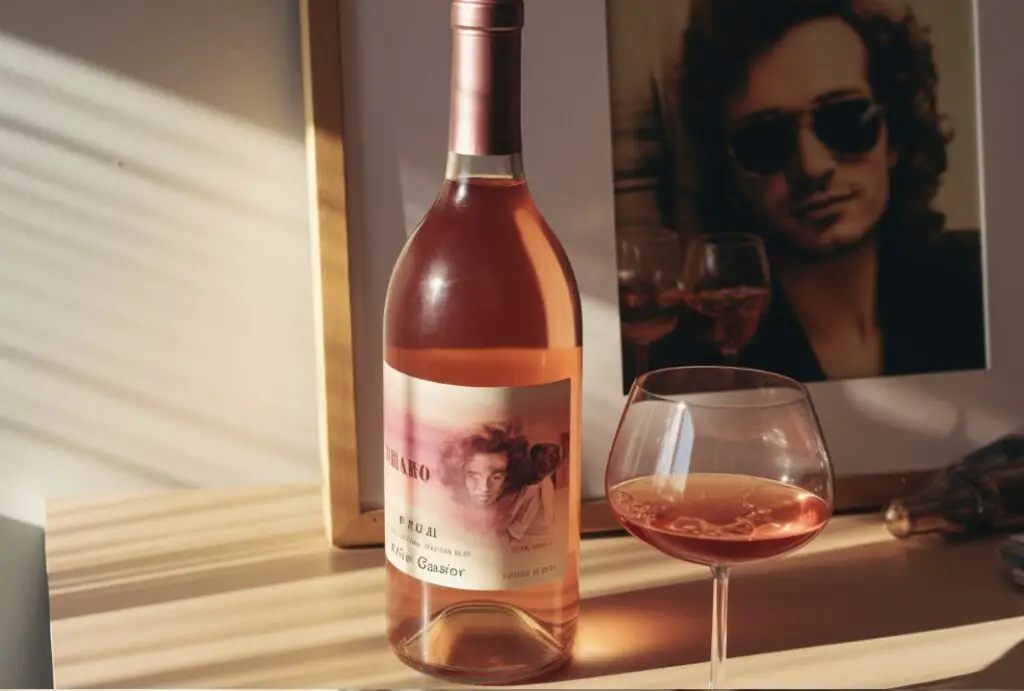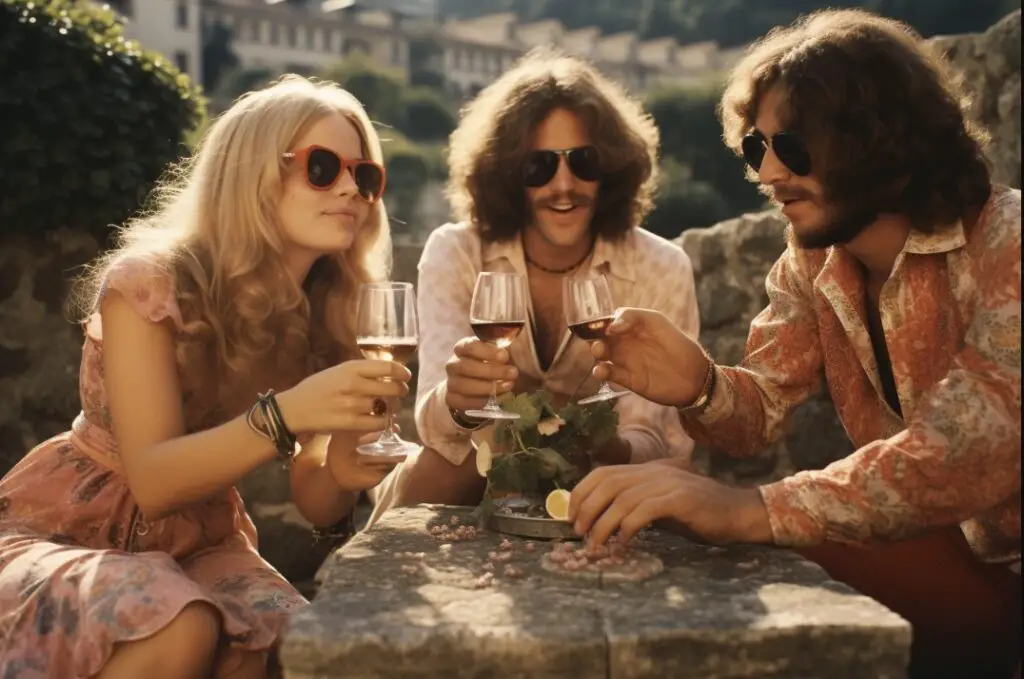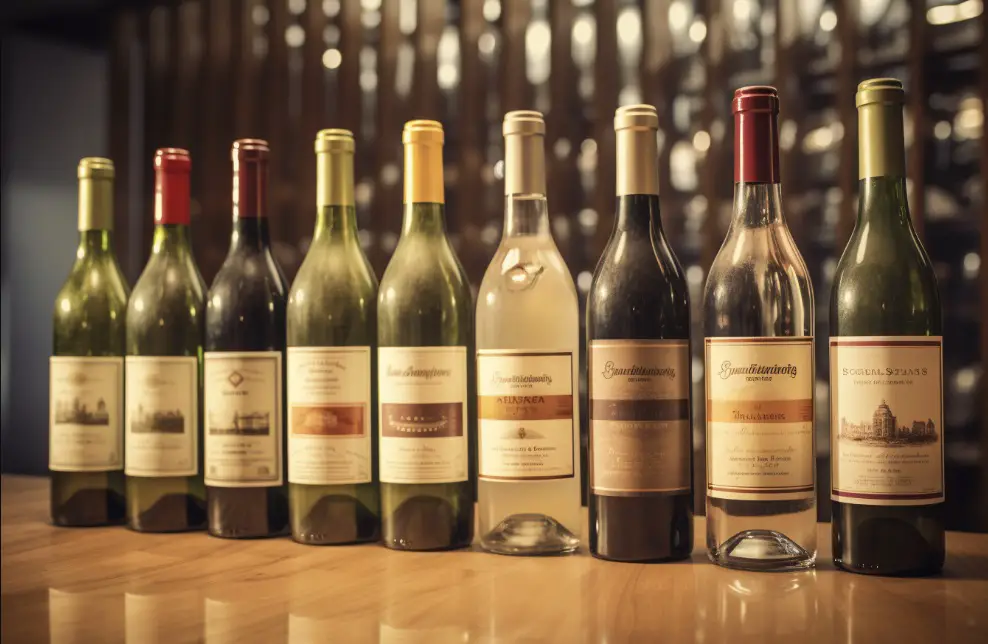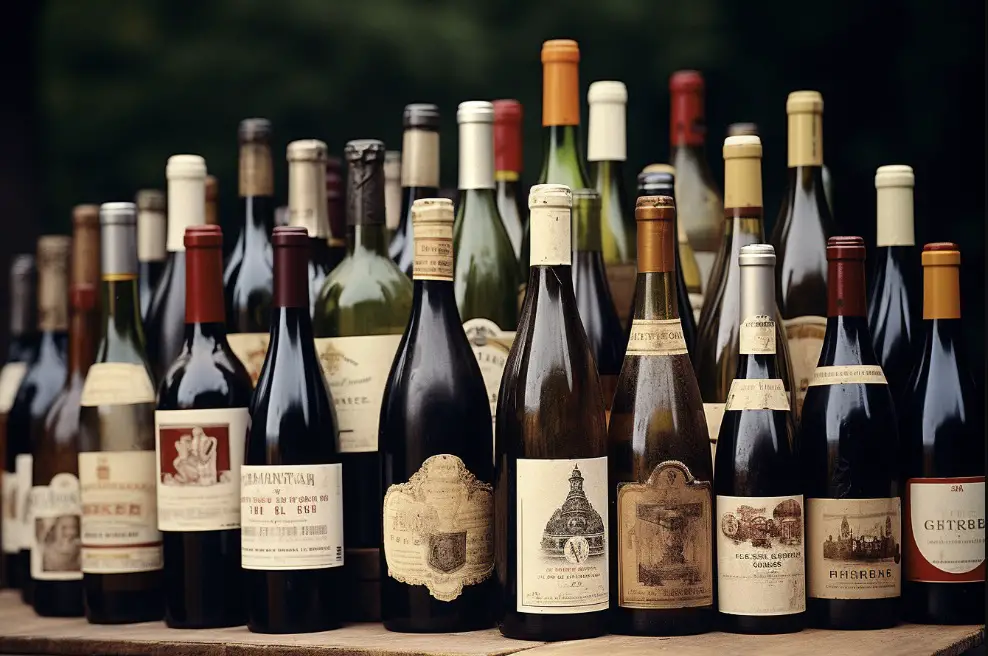The 1970s was a decade that witnessed significant changes in the world of food and drink. As people embraced new culinary trends, the popularity of wine soared.
The 1970s marked a vibrant era in the world of wine, with several notable choices captivating wine enthusiasts and casual drinkers alike. Here are some popular wines from that decade that left a lasting impression:
- Cold Duck: Originating from Germany, Cold Duck gained popularity in the U.S. This sweet sparkling wine was a unique blend of leftover champagne, wine dregs, lemons, and mint, offering a fizzy and distinctive taste.
- Blue Nun: Blue Nun, a beloved white wine, gained attention in the early 1970s. With its sweet floral notes and ripe stone fruit flavors, it became a favorite among new wine enthusiasts seeking a delightful and approachable option.
- Lambrusco: Hailing from Italy, Lambrusco enjoyed widespread recognition in the U.S. thanks to a successful marketing campaign. This medium-sweet red wine appealed to the American taste buds of the time and became a household name.
- Chianti: Another Italian gem, Chianti, found its way into the hearts of wine aficionados during the 70s. Known for its bold flavors and versatility, this red wine became a popular choice for pairing with traditional Italian cuisine.
- Mateus Rosé: Mateus Rosé, a refreshing, budget friendly, Portuguese wine, became a sensation in the 1970s. Recognizable by its distinct flattened flask-like bottle and pale pink color, it offered a slightly sweet taste with hints of strawberries and citrus, making it perfect for casual and outdoor gatherings.
- Lancers: Lancers, another Portuguese wine, achieved great popularity in the 1970s. This medium-bodied and slightly effervescent wine boasted a vibrant red color and a balanced, fruity flavor profile, appealing to a wide range of wine drinkers.
Wine became more accessible, and people started exploring different varietals and styles. In this blog post, we will explore the wine trends that dominated the 70s and discuss some of the popular wine brands of that era.
The Wine Trends of the 1970s
During the 1970s, several wine trends emerged that shaped the way people perceived and consumed wine. Some of the notable trends include:
- Fondue parties: Fondue became a popular social activity, and wine was often paired with this communal dish. People gathered around a pot of melted cheese or chocolate, enjoying the flavors and camaraderie. Wine, especially white wine, was the beverage of choice for fondue parties.
- Mateus Rosé: Mateus was a Portuguese brand that gained immense popularity in the 70s. Its distinctive squat bottle design and sweet floral flavor appealed to a wide audience. Mateus Rosé became a staple at many social gatherings and parties during this decade.
- Quiche: Quiche became a fashionable dish in the 70s, and wine was often enjoyed alongside this savory pastry. Quiche Lorraine, made with eggs, cheese, and bacon, was a particular favorite. Wine, especially light white wines like Chardonnay or Riesling, complemented the rich flavors of quiche.
- White Zinfandel: One of the most significant developments in the 70s was the accidental creation of White Zinfandel by Bob Trinchero at Sutter Home Winery. This slightly sweet and pink-colored wine became immensely popular and played a crucial role in introducing many Americans to wine.
- Crock-Pot cooking: As more women entered the labor force, convenience became a priority in the kitchen. The invention of the Crock-Pot, a slow cooker, allowed busy families to enjoy home-cooked meals without much effort. Wine was often paired with these delicious and easy Crock-Pot recipes.
- Brunch: The relaxed and informal nature of brunch made it a popular meal option in the 70s. Whether it was an indulgent eggs Benedict or a healthy fruit salad, wine accompanied the leisurely Sunday mornings spent with family and friends.

The Popularity of Wine among the masses in the 70s
The 1970s witnessed a surge in wine consumption, with Americans spending close to $2 billion on wine during this decade.
Wine was no longer reserved for special occasions but became a part of everyday life for many people.
The rise of California wines, highlighted by the famous Judgment of Paris tasting in 1976, helped bring awareness to the quality and diversity of American wines.

Popular wine brands of the 70s, such as Blue Nun and Mateus Rosé, held a special place in people’s hearts and glasses. These wines represented the carefree and fun-loving spirit of the era.
In conclusion, the 1970s were a transformative period for the wine industry. Wine became more accessible, and people enthusiastically embraced new styles and flavors.
The wine trends of the 70s left a lasting impact on the way people enjoy and appreciate wine today.
II. Blue Nun
The Rise of Blue Nun in the 70s
In the 1970s, one wine brand that gained significant popularity was Blue Nun. Blue Nun was a German wine that became a global phenomenon during this decade. It was known for its easy-drinking, semi-sweet taste that appealed to a wide range of consumers. The wine was particularly popular in the United Kingdom and the United States, where it sold millions of cases annually.

Blue Nun’s rise to fame can be attributed to several factors. Firstly, it was marketed as a wine that could be enjoyed throughout an entire meal, making it accessible and versatile for consumers. This eliminated the intimidating aspect of pairing wines with specific dishes and made Blue Nun a go-to choice for many.
Another reason for Blue Nun’s popularity was its strategic marketing strategy. The brand focused on highlighting its consumer-friendly label, which featured a picture of nuns wearing blue habits. This visual branding made the wine easily recognizable and memorable for consumers.
Additionally, Blue Nun targeted new wine drinkers who were looking for an inexpensive, sweet wine that had lower alcohol content. The brand positioned itself as the wine that goes with every dish, appealing to those who were just starting to explore the world of wine.
Blue Nun’s Marketing Strategy and Success
Blue Nun’s success can also be attributed to its consistent quality and flavor profile. Regardless of the year or origin, Blue Nun aimed to deliver a consistent product. This approach allowed consumers to trust the brand and rely on its taste, making it a reliable choice for many.
The brand’s success inspired other similar wines to enter the market, following Blue Nun’s lead in terms of branding and taste. This created a trend of easy-drinking, semi-sweet wines that appealed to novice wine drinkers.

However, as tastes and preferences evolved over time, Blue Nun eventually faced a decline in popularity. The wine began to be perceived as outdated and tacky, losing its appeal among more sophisticated wine connoisseurs. Nonetheless, Blue Nun’s impact on the wine industry in the 1970s cannot be ignored, as it paved the way for the mass-market success of other wine brands.
In conclusion, Blue Nun was one of the most popular wine brands in the 1970s. Its easy-drinking, semi-sweet taste, coupled with its consumer-friendly branding and marketing strategy, contributed to its widespread success.
The wine became synonymous with the era, representing a time when wine was becoming more accessible to the masses. While its popularity eventually waned, Blue Nun left a lasting impact on the wine industry of the 70s.
III. Cold Duck
The Origins of Cold Duck Wine
Cold Duck wine originated in Germany, where it was created as a blend of leftover champagne, wine, lemons, and mint. It was first standardized as a mixture of one part regional wine, one part wine from another region, and one part champagne, seasoned with various herbs and spices.
The name “Cold Duck” is a variation of the German term “kalt ente,” which means “cold end”. It was later modified to the similar-sounding term “Cold Duck”.
Harold Borgman, the owner of Pontchartrain Wine Cellars, invented the modern Cold Duck in 1937. He poured champagne and sparkling wine into a hollow-stem wine glass simultaneously to create a unique sparkling wine experience.
The Popularity and Reception of Cold Duck in the 70s
During the 1970s, Cold Duck experienced a surge in popularity and became a trendy wine for parties and gatherings. It was widely consumed at social events due to its affordability and sweet taste.
Despite its popularity, Cold Duck garnered mixed reviews. Some people enjoyed its fizzy and grapey flavor, likening it to fizzy grape juice. However, others found its taste to be bitter, with medicinal undertones resembling fizzy cough syrup.
Despite the polarizing opinions, Cold Duck managed to sell more than two million cases annually during its heyday in the 70s.
Overall, Cold Duck wine had a significant presence in the 1970s and was a popular choice among wine enthusiasts. Its unique origins and distinct flavor made it a memorable wine of the era, evoking nostalgia for those who experienced it firsthand. [1][2][3]
IV. Lancers and Mateus
The 1970s was a decade known for its unique trends, and that included the popularity of certain wines.

Two wines that took the 70s by storm were Lancers and Mateus, both hailing from Portugal. These medium-sweet wines captured the attention of wine enthusiasts and became must-haves for many gatherings and social events during that time.
Let’s take a closer look at the unique appeal of Lancers and Mateus.
The Portuguese Wines Taking the 70s by Storm
Lancers and Mateus were both Portuguese wines that gained immense popularity in the 70s.
They brought a distinctive flavor and style to the wine scene, captivating the taste buds of wine lovers around the world. Here is a closer look at each wine:
- Lancers: Lancers was a fruity, slightly fizzy red wine that originated from Emilia, Italy. It entered the United States market in 1967 and quickly became the most popular Italian red wine in the country. Its refreshing taste, reminiscent of strawberry soda, made it a favored choice among wine enthusiasts.
- Mateus: Mateus Rosé, a product of Portugal, gained a celebrity following during the 70s. Queen Elizabeth herself was a fan of this wine, and even rock legend Jimi Hendrix was photographed enjoying it. Mateus had a unique appeal, thanks to its slightly sweet and effervescent qualities. It boasted notes of strawberry and watermelon, making it a delightfully refreshing choice, especially on hot days.

The Unique Appeal of Lancers and Mateus
What set Lancers and Mateus apart from other wines of their time was their distinct characteristics and visual appeal. Here are some notable features that made them stand out:
- Lancers:
- Fruity and slightly fizzy, offering a refreshing taste
- Perfect for creating sangria or enjoying on its own
- Recognizable by its distinct blue nun label
- Mateus:
- Slightly sweet with a touch of fizz, providing a refreshing experience
- Noted for its vibrant strawberry and watermelon notes
- Iconic green pot-bellied bottle shape inspired by military canteens
During the 70s, Lancers and Mateus added a touch of excitement and uniqueness to the wine-drinking experience. Their popularity soared, not only for their taste but also for their associations with cultural icons and their vibrant packaging.
As the years have gone by, these wines have retained their vintage charm. While they may not dominate the current wine market, they still hold a special place in the hearts of those who remember the trends of the 70s.
V. Other Popular Wines of the 70s
During the 1970s, there were several wines that gained popularity and became household names. These wines were often inexpensive and easy to find, making them a popular choice among wine enthusiasts and casual drinkers alike.
Night Train
Night Train: This fortified wine was known for its high alcohol content and sweet flavor. It became popular due to its affordability and the unique buzz it provided. Night Train was often enjoyed by young adults looking for a cheap and potent drink.
Thunderbird
Thunderbird: Another popular fortified wine, Thunderbird was known for its fruity taste and high alcohol content. It gained a reputation as a drink of choice for college students and young adults due to its low price and easy availability.
Ripple
Ripple: Ripple was a carbonated and fortified wine that became popular for its refreshing taste. It was often enjoyed during casual gatherings and parties. Ripple offered a unique drinking experience with its bubbly texture and fruity flavors.
MD 20/20
MD 20/20: Also known as “Mad Dog,” MD 20/20 was a flavored fortified wine that gained popularity for its affordable price and variety of flavors. It became popular among young adults, who enjoyed its bold and sweet taste.
Boone’s Farm Cisco
Boone’s Farm Cisco: This wine brand offered a range of affordable and fruity flavors that appealed to a wide audience. It became popular for its approachable taste and served as an entry point for many individuals who were new to wine.
These wines were popular in the 70s due to their affordability, wide availability, and easy-drinking characteristics. They provided an accessible option for individuals seeking a casual and enjoyable wine-drinking experience.
Tasting notes and characteristics of each wine:
- Night Train: Sweet, high alcohol content
- Thunderbird: Fruity, high alcohol content
- Ripple: Carbonated, fruity, refreshing
- MD 20/20: Flavored, bold, sweet
- Boone’s Farm Cisco: Fruity, approachable
These wines had a significant impact on the wine industry, as they introduced a broader audience to the world of wine. They helped break down barriers and stereotypes associated with wine, making it a more accessible and inclusive beverage.
The Role of Cheap Wines in the 70s Wine Culture
During the 70s, there was a shift in wine culture, with more emphasis on affordable and approachable options. Cheap wines like Night Train, Thunderbird, Ripple, MD 20/20, and Boone’s Farm Cisco played a crucial role in this cultural shift by providing an entry point for individuals who were new to wine.

These wines helped demystify the world of wine, making it more accessible to a wider range of consumers. They offered an affordable and enjoyable drinking experience, encouraging experimentation and exploration within the wine world.
As a result, the popularity of these cheap wines paved the way for the emergence of a more diverse and inclusive wine culture, where individuals from all walks of life could find enjoyment in this timeless beverage. [4][5][6]
VI. The Evolution of Wine in the 21st Century
The Enduring Legacy of 70s Wine Culture
The 1970s marked a significant period of growth and popularity for the wine industry, with various wines becoming favorites among American consumers. While tastes and preferences have evolved over the years, the enduring legacy of 70s wine culture cannot be denied. Let’s take a closer look at some of the wines that were popular during that era:
- Cold Duck: Cold Duck was a sweet sparkling wine that originated in Germany and gained popularity in the U.S. It was a blend of leftover champagne, wine dregs, lemons, and mint, offering a unique and fizzy taste.
- Blue Nun: Blue Nun was a popular white wine that first gained attention in the early 1970s. It was a sweet floral wine with ripe stone fruit notes, making it a favorite among wine enthusiasts.
- Lambrusco: Lambrusco, originating from Italy, had a successful marketing campaign that helped make it a household name in the U.S. It was a medium-sweet red wine that appealed to the American taste buds of the time.
- Chianti: Chianti, also from Italy, was another wine that gained popularity in the 70s. It was a red wine known for its bold flavors and versatility, making it a popular choice for pairing with Italian cuisine.
- Mateus Rosé: Mateus Rosé was a light and refreshing Portuguese wine that became a sensation in the 1970s. It was known for its distinct bottle shape, with a flattened flask-like design and a pale pink color. Mateus Rosé offered a slightly sweet taste with hints of strawberries and citrus, making it a popular choice for casual and outdoor gatherings.
- Lancers: Lancers was another Portuguese wine that achieved great popularity in the 1970s. It was a medium-bodied, slightly effervescent wine with a vibrant red color. Lancers had a balanced and fruity flavor profile, making it a versatile choice that appealed to a wide range of wine drinkers.
These wines, with their unique characteristics and flavors, played a significant role in shaping the wine culture of the 70s. They symbolize a time of exploration and enjoyment, as Americans embraced the world of wine and sought new experiences.

While tastes and trends have evolved since then, many of these wines still hold a special place in the hearts of wine enthusiasts who fondly remember the 70s. Their popularity paved the way for the diverse and vibrant wine industry we witness today.
Whether you’re a fan of the 70s wine culture or exploring new wines, it’s fascinating to see how the wine world has evolved over time. The 70s were a transformative decade for the industry, capturing the essence of a changing culture and the growing appreciation for wine.
Stay tuned as we continue our journey through the evolution of wine in the 21st century, exploring the latest trends, emerging wine regions, and innovative winemaking techniques that shape the wines we enjoy today.
VII. Conclusion
Reflecting on the Wine Trends of the 1970s
The 1970s was a decade of experimentation and innovation in the wine industry. Americans spent billions of dollars on wine consumption during this time, and several trends emerged that shaped the way people enjoyed wine.
Let’s take a moment to reflect on the most popular wine trends of the 1970s:
- Cold Duck: This sweet sparkling wine, often made with concord grapes, gained popularity as a fizzy and fruity alternative to traditional wines. It was a favorite for special occasions and had a distinctive taste that some likened to fizzy cough syrup.
- Blue Nun: This German wine became a favorite for many wine enthusiasts in the 1970s. It was a sweet floral wine with ripe stone fruit flavors, and it maintained its popularity throughout the decade.
- Lambrusco: This Italian wine gained fame through its catchy marketing campaign, with the slogan “Riunite on ice, that’s nice!” Lambrusco was a sparkling red wine that was served chilled and became a popular choice among Americans in the ’70s.
- Chianti: Another Italian wine that gained popularity in the ’70s was Chianti. It became known for its distinctive straw-covered bottle, called a fiasco, and its robust flavors of ripe cherry and earthiness.
Overall, the 1970s was a time of excitement and experimentation in the wine world. People were open to trying new and different wines, and these trends became part of the cultural landscape of the decade.
As we look back on these wine trends, it’s interesting to see how tastes and preferences have evolved over time. While some of these wines may have fallen out of favor, they still hold a nostalgic place in the hearts of those who enjoyed them during this iconic era.
Cheers to the wine trends of the 1970s, and may we continue to explore and appreciate the ever-changing world of wine! [7]




